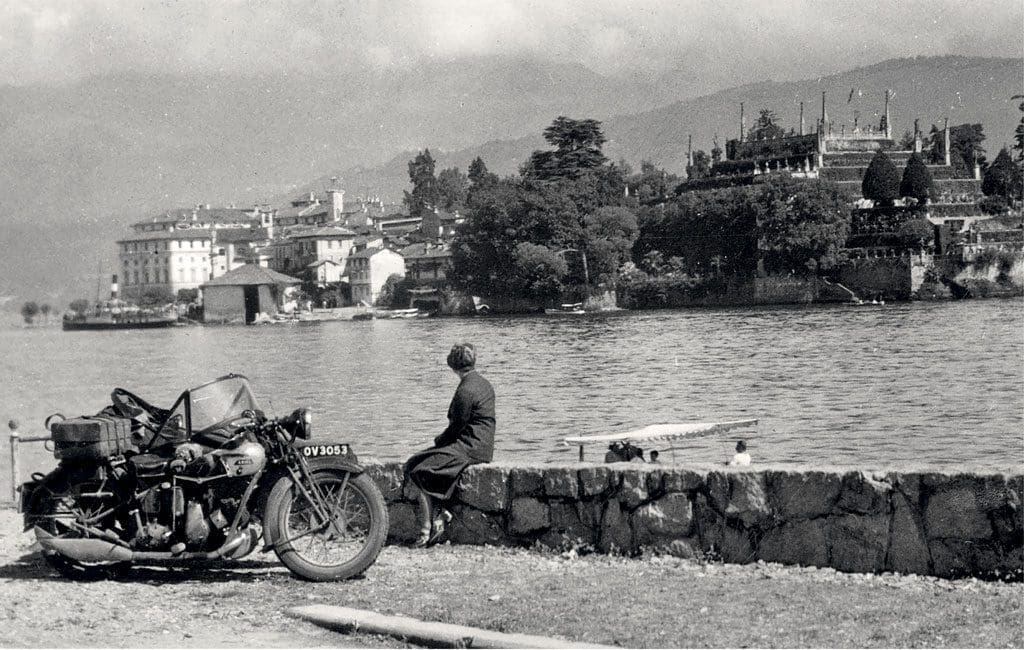Image: Mortons Archive
Despite the economic hardships of the time and the fact the exchange rate was terrible, a European tour was still undertaken.
Paused by the side of the road, a 1931 550cc Ariel side-valve ‘Sloper’ and sidecar, which has ferried The Motor Cycle’s correspondent Wharfedale (real name Donald Smith, The Motor Cycle’s Northern correspondent) and his wife on a continental trip ‘from Manchester to Maggiore’ – which was where the picture was taken. In the background – gazed on by Mrs W/S – is Isola Bella, ‘the beautiful island’, while the Ariel awaits further instruction.
Ariel’s new Sloper was the very height of fashion – the Selly Oak, Birmingham, firm took the trend for sloping engines further than most, with the motor inclined at 60 degrees. There were two overhead valve models in 1931 – the SF31 and the SG31, the former with two-valve head, the latter with four-valves – as well as the one featured here, the SB31 side-valve.
Enjoy more classic motorcycle reading, Click here to subscribe to one of our leading magazines.
Despite its older engine configuration, the SB shared the other models’ duplex downtube frame, which straddled the engine, and four-speed Burman gearbox, of a clean design and looking much like gearboxes would for the next 25-plus years; the Sloper models were much shorter lived, only listed for 1931 and 1932.
Wharfedale detailed the couple’s experiences over two consecutive issues in November 1931. During 1930, he’d visited the area he now revisited, while reporting on the International Six Days Trial. Clearly impressed, he endeavoured to return, this time bringing his wife.
“There was a lot of thinking to be done when the mission was made,” he writes. “Plans, maps, and, most important of all, finance, had to be considered from every angle. Kit was collected and the machine was prepared to face every conceivable emergency and, finally, on a pouring wet Monday, we started out for Lake Maggiore, Stresa, and sunshine.”
The Ariel was ‘most elaborately fitted up by the makers, thoughtfully provided, at Harry Perry’s [Perrey was Ariel’s star trials rider and competition manager] suggestion, with 27in by 4in tyres.’ It was agreed that, on route from Manchester, the tourists would call at Birmingham for the machine to be given the ‘once over’ then press on to Dover. But all didn’t go to plan.
“Thirty miles had been covered when I assailed that uneasy feeling I had forgotten something. Now, what could it be? No! Yes! It was! I had forgotten my driving licence.”
This all sends the plans awry, necessitating an early morning (3 am) start the day after, and, despite running out of petrol in London, they make the ferry in good time, the Ariel last to be loaded ‘…in favour of all the Rolls-Royces and such of the wicked rich.’
Across the water to Calais, then into Belgium and a couple of overnight stops, before into Germany, and three more nights, which included encountering a German waiter who had been interned in the Isle of Man during the war.
Next was Switzerland and the Alps, before Italy and, eventually, the town of Stresa.
‘“Tomorrow,’ I said to my better-half passenger ‘you will see the most beautiful place in Northern Italy and tonight you will drink the most lovely wine of the land.”’
It didn’t quite work like that – the wine was good but next morning’s weather more Manchester than Maggiore. ‘… we promenaded in raincoats’ the comment.
Still, Isola Bella (320 metres long by 400 metres wide, which features a palace, an Italianate garden and a small fishing village, and was named after Isabella D’Adda, wife of Carlo III of the House of Borromeo, who, in 1632, began its transformation to what it is now) was explored, before next day it was time to head home; the sun was now shining, but time was pressing.
Switzerland turned to France and more mountain passes (“Two miles on full bore in second and first caused the motor to get a little warm”) and more exploring into Switzerland again – including pausing in Geneva – then to France and, eventually, Paris, with some battling with the capital’s traffic: “They don’t encourage the form of driving which the motorist of the ‘popular car’ type in England believes to be safe driving.”
Next day it was on to Calais – but, with 130 miles to go, ‘…one of those expensive noises occurred in the machinery.’ But it wasn’t as catastrophic as feared; part of the shock absorber had come adrift in between the chain and sprocket. With the help of a garage, the sidecar was removed, and, after four-and-a-half hours’ work, the problem remedied. After another night, it was Calais again, then back on the boat, reaching London the same evening.
Next morning, London to Birmingham – for the transmission to be properly sorted – then home to Manchester. They’d covered 2500 miles, over 16 days, at an all in cost of less than £40. And the last word to Wharfedale: “We hadn’t found much sunshine, but we had a store of golden memories.”



